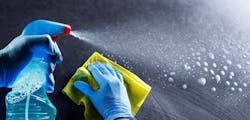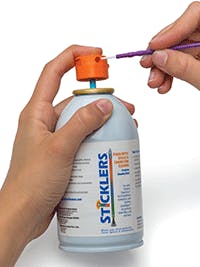Fiber Field Cleaning Best Practices Post-COVID-19
Before the COVID-19 pandemic, many fiber installers likely didn’t think much about whether they were cleaning their fiber optic connections correctly. But now, in the COVID-19 world, cleaning is on nearly everyone’s mind. It is a primary focus and a top priority for many whether at home or at work. Even fiber optics cleaning is taking on more importance.
In the midst of the COVID-19 pandemic, millions of people changed the way they communicate. Almost overnight, employees started working in their virtual offices from home. Face-to-face sales calls and in-person meetings quickly morphed into video chats and conference calls. Others in self-isolation spent more time gaming, watching and shopping online. This sudden and drastic switch to more digital communication underscores the critical need for a robust and reliable fiber network to keep us all connected. And in turn, why fiber cleaning is essential to ensure flawless network performance and reliability.
When installing or maintaining fiber optic networks in the field there are specific processes for cleaning. These include cleaning methods to not only provide a cleaner, safer work environment, but also to help ensure installers create perfectly reliable and clean fiber optic splices and connectors. Here are some suggestions to help boost your post-COVID-19 fiber optic cleaning success.
InvisiLight® Solution for Deploying Fiber
April 2, 2022Go to Market Faster. Speed up Network Deployment
April 2, 2022Episode 10: Fiber Optic Closure Specs Explained…
April 1, 2022Food for Thought from Our 2022 ICT Visionaries
April 1, 2022Follow Local Health Agency Guidelines
• When working at a jobsite, always wash your hands before eating and after using the bathroom.
• If you’re not near a sink, use a hand sanitizer containing at least 60% alcohol.
• Observe the recommended social distancing guidelines, and wear a face mask if you are working near others.
Prepare for Fiber Cleaning
• Wipe down your work surface and tools before starting the fiber cleaning. A good once-over with a general purpose presaturated wipe removes dirt, dust and any contaminant that might be lurking on the work surface, and gives you a fresh starting point.
• Wash your hands before handling any fiber optic connectors and your cleaning tools. Clean hands are less likely to transfer dirt and oils to the fiber components. Plain soap and water work best.
• Don’t apply moisturizer to your hands prior to cleaning the termini. This attracts more contaminants, and causes moisturizer oils to transfer onto the cleaning wipe or swab — potentially contaminating the end-face you are trying to clean.
• Don’t wear disposable gloves when working with wipes and swabs. While you may think that wearing gloves protects the cleaning materials from the oils in your skin, you may actually be adding more particulate. Gloves are a carrier of all kinds of microscopic contaminants. It’s best to thoroughly wash your hands prior to cleaning a connector. Plus, it helps keep gloves more readily available for frontline health care workers who need them.
• When cleaning fiber end-faces, wipe the outside of the mated end-face pair before disconnecting to remove the heavy soil first.
• If fiber splicing, clean the fiber prior to cleaving only. There is nothing cleaner than the end-face of a newly cleaved fiber, so do not clean again. Otherwise, the fiber ends may be recontaminated.
• Always keep a ready supply of cleaning fluids and tools on-hand. Whether purchasing a complete fiber cleaning kit or simply stocking up, be sure to have a plentiful supply of cleaning fluid, wipes, and other cleaning tools, ready. This prevents you from borrowing or sharing items that could possibly spread the virus.
Replace the IPA (Isopropyl Alcohol)
Many fiber installers follow the international standard IEC 61300-3-35 for cleaning fiber optic connectors and use the wet/dry cleaning method as recommended. However, they use alcohol for wet/dry cleaning their fiber splices and end faces. Due to the COVID-19 pandemic, IPA is in short supply. Nearly every industry is using IPA to clean and disinfect their workplaces. Not to mention hospitals and other health care facilities that require IPA for killing viruses and bacteria.
So, IPA is now a rare and more expensive commodity. Many fiber installers face IPA shortages. And if they do manage to source IPA, it is expensive. Fueled by the increased demand and limited supply, IPA is sometimes up to 4 times more expensive than before the COVID-19 outbreak.
Fortunately, there are better cleaning fluids than IPA for fiber optic splices and connections. Switching to one of these alternatives not only provides you with excellent cleaning results, it helps keep IPA available to the medical facilities that need it more.
Cleaning Fluid and Stixx: Hermetically sealed cleaning fluid containers prevent cross-contamination and spilling.
One IPA alternative option is The Sticklers™ Fiber Optic Splice & Connector Cleaner fluid. It cleans better than IPA and is safer to use. Plus, since this cleaning fluid is not IPA-based, it is in plentiful supply, and isn’t impacted by the overwhelming global demand for IPA. It is available and ready to ship anywhere in the world.
Here are some other things to look for in an IPA replacement fiber optic cleaning fluid:
• No residue. Unlike alcohol, specialized fiber optic cleaning fluids remove contaminants without leaving a haze when it dries. Any residual haze often causes insertion loss or faulty signal transmission.
• Thorough cleaning. Specialized fiber cleaning fluids are not hygroscopic, meaning they won’t absorb impurities from the air like alcohol does. This translates to better end-face or splice cleaning.
• Fast drying. Fiber optic cleaning fluids evaporate up to 8 times faster than IPA. This saves installers cleaning time.
• Static-dissipative. A static-dissipative fiber cleaning fluid eliminates surface static that attracts impurities, especially dust from concentrating on the end-faces and splices.
• Nonflammable. Unlike alcohol, specialty fiber optic cleaning fluids are nonflammable, so they are safer to use in the field.
• Sealed for purity. Alcohol purchased over the counter is typically diluted with up to 40% water, and is hard to buy in high-purity packaging (it typically comes in just a plastic bottle). An unopened bottle typically is not nearly the purity needed for cleaning optics. And it only gets worse because the open bottle makes it difficult to keep contents clean and uncontaminated with day-to-day use. Specialty fiber optic cleaning fluids typically come in hermetically-sealed dispensers. This keeps out contaminants. It also prevents spills if they tip over in a tool kit or while in use. Plus, a metered dose dispenser cap controls fluid waste and installer exposure.
• Non-hazardous, non-regulated shipping. This means installers can safely travel with the fiber cleaning fluid on their vehicles without worry. They can even put a 3oz. can into their carry-on bag to pass through TSA screening if they need to fly to their job site.
Like this Article?
Subscribe to ISE magazine and start receiving your FREE monthly copy today!
Fiber for the Future
There is no doubt that reliable, trouble-free fiber optic networks are the key to our post-COVID-19 interconnected future. But one of the biggest threats to fiber signals today is contamination. So, it is important that fiber splices and connections are clean in order to keep networks operating reliably. However, some fiber cleaning methods and fluids must adapt to the changes and challenges imposed by the COVID-19 pandemic. Now is a good time for you to review your current cleaning tools and methods and switch to better ways to ensure your fiber cleaning success.
When choosing fiber optic cleaning fluids and methods, you should seek the help of an experienced supplier that specializes in fiber cleaning. They can advise you on which cleaning fluids, tools, and methods, will work best for your fiber optic networks.
About the Author






